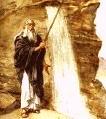Appendix 1: The People Of The Parables
Interpreting The Parables
Itís important to read the parables correctly. The parables of the Rabbis
were used to explain doctrines which they had already stated in so many
words. The parables of the Lord Jesus are different; they are themselves
His message, the Gospel of the Kingdom, and not just illustrations of
things which He had elsewhere plainly stated. The sheer number of parables
in the Lordís teaching is itself striking; to understand them is to understand
His message. Some estimate that around one third of the Lordís teaching
was in parables, and that He spoke about 60 parables(1).
Whilst the Rabbis occasionally used parables, hardly any great teacher
has more than two parables attributed to him(2).
Paul, as we have shown elsewhere, so frequently alluded to the parables,
both consciously and unconsciously. They made a huge impact on him, as
they should with us. Indeed, the list of his sufferings in 2 Cor. 11:23-27
use the very terms which we meet in the Lordís parables of judgment- being
hungry, thirsty, cold, naked, beaten, threatened, imprisoned etc. ďA parableĒ
is likened to a thorn that goes into a manís hand in Prov. 26:9. Only
a fool will respond to it like a drunk man, numb to the pain. Parables
arenít painless, homely stories. Simple as that.
1-1
Elements Of Unreality
1-2
End Stress
1-3 The Sower Parable
1-4 The 11th Hour Worker
1-5 The Two Carpenters
1-6 The Fanatic Shepherd
1-7 Parables
of Israel
1-8 The Call Of The
Gospel
1-9 The Parables Of
Judgment
1-10 Divine Delegation
1-11
Unanswered Questions In The Parables
2-1 The Parable Of
The Prodigal
2-2 Prodigal Israel
2-3 The Prodigal's
Repentance
2-4 Killing
The Fatted Calf
2-5 The Elder Brother
3-1 The Good Samaritan
Notes
(1) T.W. Manson, The
Teaching of Jesus (Cambridge: C.U.P., 1951) p. 69 lists 65 parables
of Jesus. A.M. Hunter analyzed the teaching of the Lord Jesus and found
that ďthe parables of Jesus comprise more than one-third of his recorded
teachingĒ, and that in Luke, 52% of the Lordís recorded teaching is parables!
See A.M. Hunter, Interpreting The Parables (Philadelphia: Westminster
Press, 1960) p. 7.
(2) A.M. Hunter, The
Parables Then And Now (London: Westminster, 1971), p. 15.
|


